People of India :
Indians are the people who are the nationals or citizens of India, the second most populous nation containing 17.50% of the world’s population. “Indian” refers to nationality, but not ethnicity or language. The Indian nationality consists of many regional ethno-linguistic groups, reflecting the rich and complex history of India. India hosts all major ethnic groups found in the Indian Subcontinent. The diaspora populations with Indian ancestry, as a result of emigration, are somewhat widespread most notably in Asia and North America
The people of India are among the warmest and the most hospitable people in the world. They take pains to make their guests feel at home. Even today, Indian people believe in their age-old traditions and make sure the same values are passed onto future generations. The rich traditional background of our country fascinates the current generation. Even though they wear the latest fashionable accessories and flaunt the best cell phones, when it comes to respecting elders and following the religious practices, they make sure that there is no chance for complaints. Read on further for some more fascinating information about Indians.
The diverse country of India is equally diverse in its racial ethnicity also. India is probably one country in the world where you will find so many races and cultures living together in perfect harmony. The six main ethnic groups of ancient India are as follows:
- Dravidians – The people of South India, the Dravidians have been believed to come before the Aryans. They are accredited to have developed the city civilization of the Indus valley, whose remains have been found at ancient cities of Mohenjodaro and Harappa.
- Mongoloids – The Mongoloids are found in the Northeast India in the states of Assam, Nagaland, Mizoram, Sikkim, Meghalaya, Arunachal Pradesh, Manipur, and Tripura. Some of them are also found in the Himalayan region of Ladakh. They are characterized by pale complexion, small eyes and a medium built.
- Negrito – The Negritos are supposed to have been the earliest people to travel to India. They inhabited the islands of Andaman and Nicobar and their race is till continuing. Their striking feature is their broad heads like that of Africans.
- Nordic Aryans – The Nordic Aryans were the last to come to India. They are widely found in the northern and central parts of India. They have been believed to have come to India around 2000 B.C.
- Proto Australoids – These people came to India after the Negritos. The Australoids laid the foundation of Indian civilization and are accredited with the introduction of farming techniques. They grew rice and vegetables and made sugar from sugarcanes. These people are now found in some parts of India, Myanmar and the islands of South East Asia. Their characteristic features are medium height, low foreheads, wheatish complexion and flat noses.
- Western Brachycephals – These people are distributed in the western and southwest parts of India. That includes the states of Gujarat, Maharashtra and Karnataka. The Parsis are also believed to have originated from this ethnic group. These people have broad foreheads and medium built.
History :

The history of India includes the prehistoric settlements and societies in the Indian subcontinent; the blending of the Indus Valley Civilization and Indo-Aryan culture into the Vedic Civilization; the development of Hinduism as a synthesis of various Indian cultures and traditions; rise of sixteen oligarchic republics known as Mahajanapadas; rise of Śramaṇa movement; birth of Jainism in 9th-century BCE and Buddhism in 6th-century BCE, and the onset of a succession of powerful dynasties and empires for more than two millennia throughout various geographic areas of the subcontinent, including the growth of Muslim dynasties during the Medieval period intertwined with Hindu powers; the advent of European traders resulting in the establishment of the British rule; and the subsequent independence movement that led to the Partition of Indiaand the creation of the Republic of India.
The Indian people established during ancient, medieval to early eighteenth century some of the greatest empires and dynasties in South Asian history like the Maurya Empire, Satavahana dynasty, Gupta Empire, Rashtrakuta dynasty, Chalukya Empire, Chola Empire, Karkota Empire, Pala Empire, Vijayanagara Empire, Maratha Empire and Sikh Empire.The first great Empire of the Indian people was the Maurya Empire having Patliputra(currently Patna, Bihar) as its capital, conquered the major part of South Asia in the 4th and 3rd century BC during the reign of the Indian Emperors Chandragupta Maurya and Ashoka alongside their senior advisor, Acharya Chanakya, the pioneer of the field of political science and economics in the World. The next great ancient Empire of the Indian people was the Gupta Empire. This period, witnessing a Hindu religious and intellectual resurgence, is known as the classical or “Golden Age of India”. During this period, aspects of Indian civilisation, administration, culture, and Hinduism and Buddhism spread to much of Asia, while Chola Empire in the south had flourishing maritime trade links with the Roman Empire during this period. The ancient Indian mathematicians Aryabhata, Bhāskara I and Brahmagupta invented the concept of zero and the Hindu–Arabic numeral system decimal system during this period. During this period Indian cultural influence spread over many parts of Southeast Asia which led to the establishment of Indianized kingdoms in Southeast Asia
Culture :
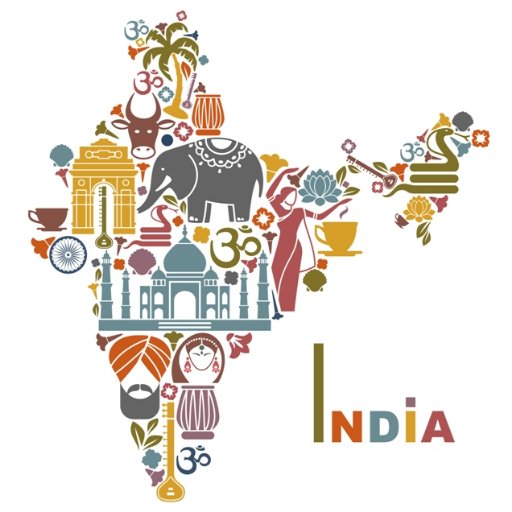
India is one of the world’s oldest civilisations. The Indian culture, often labelled as an amalgamation of several various cultures, spans across the Indian subcontinent and has been influenced and shaped by a history that is several thousand years old. Throughout the history of India, Indian culture has been heavily influenced by Dharmic religions. They have been credited with shaping much of Indian philosophy, literature, architecture, art and music. Greater India was the historical extent of Indian culture beyond the Indian subcontinent. This particularly concerns the spread of Hinduism, Buddhism, architecture, administration and writing system from India to other parts of Asia through the Silk Road by the travellers and maritime traders during the early centuries of the Common Era. To the west, Greater India overlaps with Greater Persia in the Hindu Kush and Pamir Mountains. During medieval period, Islam played a significant role in shaping Indian cultural heritage Over the centuries, there has been significant integration of Hindus, Jains, and Sikhs with Muslims across India
Religion :
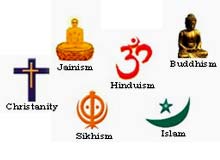
India is the birthplace of Hinduism, Buddhism, Jainism and Sikhism, collectively known as Indian religions. Indian religions, also known as Dharmic religions are a major form of world religions along with Abrahamic ones. Today, Hinduism and Buddhism are the world’s third- and fourth-largest religions respectively, with over 1 billion followers altogether, and possibly as many as 1.5 or 1.6 billion followers. Throughout India’s history, religion has been an important part of the country’s culture. Religious diversity and religious tolerance are both established in the country by the law and custom; the Constitution of India has declared the right to freedom of religion to be a fundamental right.
Atheism and agnosticism have a long history in India and flourished within Śramaṇa movement. The Cārvāka school originated in India around the 6th century BCE and is one of the earliest form of materialistic and atheistic movement in ancient India. Sramana, Buddhism, Jainism, Ājīvika and some schools of Hinduism like Samkhya consider atheism to be valid and reject the concept of creator deity, ritualism and supernaturalism. India has produced some notable atheist politicians and social reformers.
According to the 2011 census, 79.8% of the population of India practices Hinduism and 14.2% adheres to Islam, while the remaining 7.37% adheres to other religions, mostly Jainism, Buddhism, Sikhism and Christianity. Zoroastrianism and Judaism each has several thousands of Indian adherents, and also have an ancient history in India. India has the largest population of people adhering to Zoroastrianism and Bahá’í Faith in the world, even though these two religions are not native to India. Many other world religions also have a relationship with Indian spirituality, such as the Bahá’í Faith which recognises Buddha and Krishna as manifestations of the God Almighty. Despite the strong role of religion in Indian life, atheism and agnostics also have visible influence along with a self-ascribed tolerance to other people. According to the 2012 WIN-Gallup Global Index of Religion and Atheism report, 81% of Indians were religious, 13% were not religious, 3% were convinced atheists, and 3% were unsure or did not respond.
Traditionally, Indian society is grouped according to their caste. It’s a system in which social stratification within various social sections defined by thousands of endogamous hereditary groups are often termed jāti or castes. Within a jāti, there exists exogamous groups known as gotras, the lineage or clan of an individuals. Caste barriers have mostly broken down in cities but still exists in some form in rural areas.
Hinduism is the majority in most states; Kashmir and Lakshadweep are Muslim majority; Nagaland, Mizoram and Meghalaya are Christian majority; Punjab is a Sikh majority with Hindus 37%. It is to be noted that while participants in the Indian census may choose to not declare their religion, there is no mechanism for a person to indicate that he/she does not adhere to any religion. Due to this limitation in the Indian census process, the data for persons not affiliated with any religion may not be accurate. India contains the majority of the world’s Hindus, Jains, Sikhs, Zoroastrians and Bahá’í. Christianity is widespread in the Northeast India, parts of southern India, particularly in Kerala and among various populations of Central India. Muslims are the largest religious minority. India is also home to the third-largest Muslim population in the world after Indonesia and Pakistan.
Family :
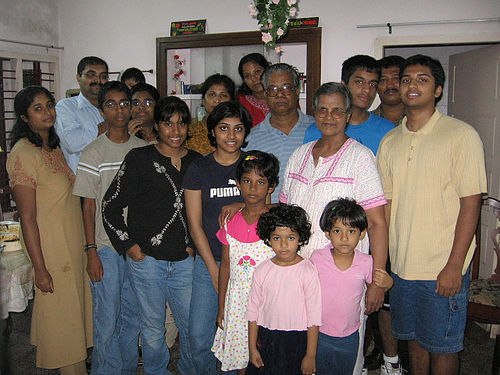
Historically, India had a prevailing tradition of the joint family system or undivided family. Joint family system is an extended family arrangement prevalent throughout the Indian subcontinent, particularly in India. The family is headed by a patriarch, the oldest male, who makes decisions on economic and social matters on behalf of the entire family. The patriarch’s wife generally exerts control over the household, minor religious practices and often wields considerable influence in domestic matters. A patrilineal joint family consists of an older man and his wife, his sons and unmarried daughters, his sons’ wives and children. Family income flows into a common pool, from which resources are drawn to meet the needs of all members, which are regulated by the heads of the family. However, with modernisation and economic development, India has witnessed a break up of traditional joint family into more nuclear families and the traditional joint family in India accounted for a small percent of Indian households.
Arranged marriages have been the tradition in Indian society. Marriage is considered a union of the two families rather than just the individuals, the process involved in an arranged marriage can be different depending on the communities and families. Recent survey study found that fewer marriages are purely arranged without consent and that the majority of surveyed Indian marriages are arranged with consent. The study also suggested that Indian culture is trending away from traditional arranged marriages, they find that the marriage trends in India are similar to trends observed over last 40 years where arranged marriages was previously common, particularly in China and Japan
Dress :
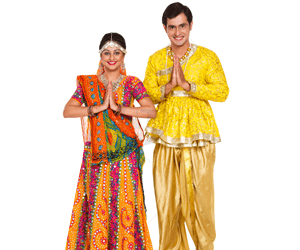
India’s clothing styles have continuously evolved over the course of history. Cotton was first cultivated in Indian subcontinent around the 5th millennium BC. Dyes used during this period are still in use, particularly indigo, red madder, lac and turmeric. Silk was woven around 2450 BC and 2000 BC. In 11th-century BC Rig-veda mentions dyed and embroidered garments known as paridhan and pesasrespectively and thus highlights the development of sophisticated garment manufacturing techniques during this period. In the 5th century BCE, Greek historian Herodotus describes the richness of the quality of Indian textiles. By the 2nd century AD, cotton, muslinsand silk textiles manufactured in India were imported by the Roman Empire and was one of the major exports of ancient India to other parts of the world along with Indian spices and Wootz steel. Traditional Indian clothing greatly varies across different parts of the country and is influenced by local culture, geography and climate. Women traditionally wear Sari, Gagra Choli, Angarkha, Phiran, Shalwar Kameez, Gharara and Bandi with Dupatta or Ghoonghat worn over head or shoulder to complete the outfit. Men traditionally wear Angarkha, Achkan, Kurta, Kameez, Phiran, Sherwani and Koti for upper garment, lower garment includes Dhoti, Churidar, Shalwar, and Lungi. Pagri is usually worn around head to complete the outfit. In urban centres, people often wear western clothing and variety of other contemporary fashion.
Cuisine :

Indian food varies from region to region. Staple foods of Indian cuisine include a variety of lentils (dal), whole-wheat flour (aṭṭa), rice and pearl millet (bājra), which has been cultivated in Indian subcontinent since 6200 BCE. Over time, segments of the population embraced vegetarianism during Śramaṇa movement while an equitable climate permitted a variety of fruits, vegetables, and grains to be grown throughout the year. A food classification system that categorised any item as saatvic, raajsic or taamsic developed in Yoga tradition. The Bhagavad Gita prescribed certain dietary practices. During this period, consumption of various types of meat became taboo, due to being considered sacred or impure. Indian cuisines use numerous ingredients, deploy a wide range of food preparation styles, cooking techniques and culinary presentation depending on geographical location.
Language :
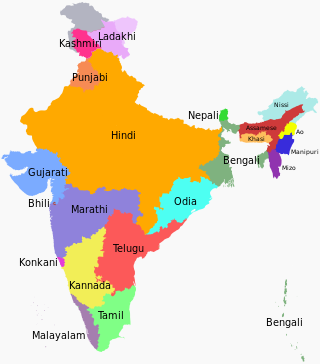
| Rank | Language | 2001 census | |
| Speakers | Percentage | ||
| 1 | Hindi languages | 422,048,642 | 41.03% |
| 2 | Bengali | 83,369,769 | 8.11% |
| 3 | Telugu | 74,002,856 | 7.19% |
| 4 | Marathi | 71,936,894 | 6.99% |
| 5 | Tamil | 60,793,814 | 5.91% |
| 6 | Urdu | 51,536,111 | 5.01% |
| 7 | Gujarati | 46,091,617 | 4.48% |
| 8 | Kannada | 37,924,011 | 3.69% |
| 9 | Malayalam | 33,066,392 | 3.21% |
| 10 | Oriya | 33,017,446 | 3.21% |
| 11 | Punjabi | 29,102,477 | 2.83% |
| 12 | Assamese | 13,168,484 | 1.28% |
| 13 | Maithili | 12,179,122 | 1.18% |
| 14 | Bhili/Bhilodi | 9,582,957 | 0.93% |
| 15 | Santali | 6,469,600 | 0.63% |
| 16 | Kashmiri | 5,527,698 | 0.54% |
| 17 | Nepali | 2,871,749 | 0.28% |
| 18 | Gondi | 2,713,790 | 0.26% |
| 19 | Sindhi | 2,535,485 | 0.25% |
| 20 | Konkani | 2,489,015 | 0.24% |
| 21 | Dogri | 2,282,589 | 0.22% |
| 22 | Khandeshi | 2,075,258 | 0.21% |
| 23 | Kurukh | 1,751,489 | 0.17% |
| 24 | Tulu | 1,722,768 | 0.17% |
| 25 | Meitei/Manipuri | 1,466,705* | 0.14% |
| 26 | Bodo | 1,350,478 | 0.13% |
| 27 | Khasi | 1,128,575 | 0.11% |
| 28 | Mundari | 1,061,352 | 0.10% |
| 29 | Ho | 1,042,724 | 0.10% |
Contribution and discoveries :
Indian people have played a major role in the development of the philosophy, sciences, mathematics, arts, architecture and astronomy throughout history. During the ancient period, notable mathematics accomplishment of India included Hindu–Arabic numeral system with decimal place-value and a symbol for zero, interpolation formula, Fibonacci’s identity, theorem, the first complete arithmetic solution (including zero and negative solutions) to quadratic equations. Chakravala method, sign convention, madhava series, and the sine and cosine in trigonometric functions can be traced to the jyā and koti-jyā. Notable military inventions include war elephants, crucible steel weapons popularly known as Damascus steel and Mysorean rockets. Other notable inventions during ancient period include chess, cotton, sugar, fired bricks, carbon pigment ink, ruler, lac, lacquer, stepwell, indigo dye, snake and ladder, muslin, ludo, calico, Wootz steel, incense clock, shampoo, palampore, chintz, and prefabricated home.
Indian cultural aspects, religions, philosophy, arts and architecture have developed over several millennia and have spread through much of Asia in peaceful manner. Many architectural structures of India such as Sanchi Stupa, Taj Mahal and Mahabodhi Temple are UNESCO World Heritage sites today.
In modern times, Indian people have continued to contribute to mathematics, sciences and astrophysics. Among them are Satyendra Nath Bose, Srinivasa Ramanujan, Jagadish Chandra Bose, Meghnad Saha, Homi J. Bhabha, Prasanta Chandra Mahalanobis and notable Nobel Prize recipients C. V. Raman, Har Gobind Khorana, Venkatraman Ramakrishnan and Subrahmanyan Chandrasekhar who is notable for currently accepted theory on the later evolutionary stages of massive stars, including black holes
Latest Govt Job & Exam Updates:
